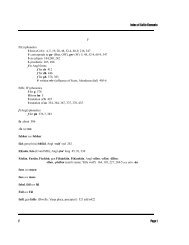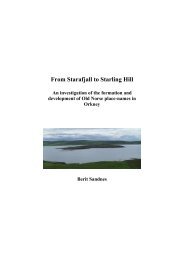May Williamson: The Non-Celtic Place-Names of the Scottish Border ...
May Williamson: The Non-Celtic Place-Names of the Scottish Border ...
May Williamson: The Non-Celtic Place-Names of the Scottish Border ...
You also want an ePaper? Increase the reach of your titles
YUMPU automatically turns print PDFs into web optimized ePapers that Google loves.
22<br />
REDKIRK (Grt): (89, 6 G):<br />
Red Kirke, 1552 Bullock. <strong>The</strong> church must have been built <strong>of</strong> <strong>the</strong> local red sandstone.<br />
SELKIRKSHIRE<br />
ASHKIRK (Ask): (80, 11 H):<br />
Ascheschyrc, c 1124 (12 th ) Glas; Hassechirke, 1165-1214 LSMM; Askirk(e), 1214-49 ib;<br />
1335-6 CDS. OE æsċ-ċiriċe, “church by <strong>the</strong> ash-tree”. Later forms in As- represent MSc asch:<br />
cf fis for fisch in Fishwick (No VII).<br />
/54/<br />
SELKIRK (Slk): (80, 11 F):<br />
Selechirche, c 1120 (c 1320) Kelso; 13 th C de M; -chyrca, c 1120 Kelso; -schirche, c 1136<br />
LSMM; c 1160-70 BM; -kirke, 1165-1214 ib; -kirche, ib; -krik, 1265 Rot Scac; Sellekirke,<br />
1263 C de M; Sel-, 1296 DIHS. <strong>The</strong> first element may be OE sele, “hall, dwelling”, or a short<br />
form, *Sela, <strong>of</strong> names in Sele-: cf Selsdon, Sr, for which a strong form *Seli is suggested (PN<br />
Sr, 54).<br />
<strong>The</strong>re are also Berrykirk (Oxn) and Brydekirk (Ann).<br />
/55/ XII OE helm<br />
Originally denoting “a helmet” this word must here be taken in <strong>the</strong> wider sense <strong>of</strong> “covering”<br />
(B-T, s.v. III), perhaps in <strong>the</strong> modern dialect meaning <strong>of</strong> “shed” (EDD, s.v. – in Y and L). <strong>The</strong><br />
first elements <strong>of</strong> <strong>the</strong> three compounds which have -helm for terminal suggest that <strong>the</strong> names<br />
are habitational.<br />
It is not impossible, however, that <strong>the</strong> term was used originally in a topographical sense,<br />
denoting ei<strong>the</strong>r “helmet-shaped hill” or “hill-top” since both Chisholme and Buckholm are on<br />
pronounced hills and Branxholme lies beneath Branxholme Braes and Branxholme Park Hill.<br />
<strong>The</strong> “lost” *Gorkhelm is actually <strong>the</strong> name <strong>of</strong> a hill-top, but may be Norse in origin.<br />
It is unlikely that <strong>the</strong> English term was used with <strong>the</strong> meaning <strong>of</strong> ON hiálmr as is suggested<br />
for English examples (DEPN, 221). Scandinavian influence was not sufficiently strong for<br />
this in our area.<br />
ROXBURGHSHIRE<br />
BRANXHOLME (Hwk): (85, 11 B):<br />
Brankishelme, 1315-21 RMS; Branxelm, 1463-4 ib; -haim, 1479 HMC (Rxb); -helme, 1540<br />
RMS. Compare Branxton Nb: Brankeston, 1249, Branxston, 1346, which contains <strong>the</strong> same<br />
first element, evidently a personal name *Bran(n)oc (PN NbDu, 30). Branxton, /56/ ELth, is<br />
Brankestun (P), c 1300 (1434) Cdstr.<br />
BUCKHOLM (Mel): (80, 12 C):<br />
Bucchehelm, 1180 APS; Buc-, 1189 LSMM; Buk-, 1548 RSS. OE bucca, “he-goat”, is <strong>the</strong><br />
first element, later associated with <strong>the</strong> more common buck, “male deer”.




